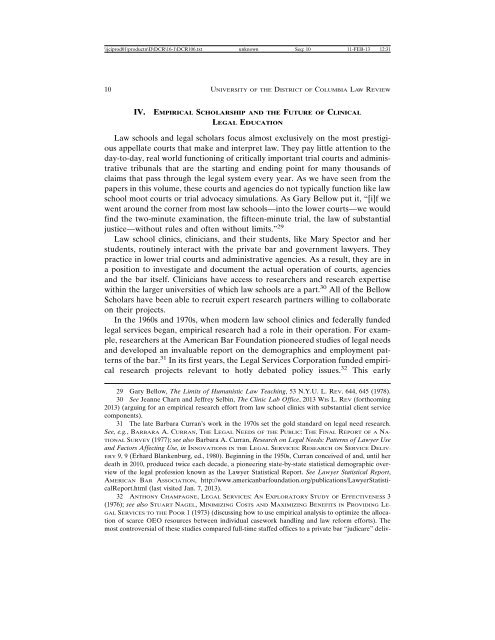volume 16, number 1 - UDC Law Review
volume 16, number 1 - UDC Law Review
volume 16, number 1 - UDC Law Review
- No tags were found...
Create successful ePaper yourself
Turn your PDF publications into a flip-book with our unique Google optimized e-Paper software.
\\jciprod01\productn\D\DCR\<strong>16</strong>-1\DCR106.txt unknown Seq: 10 11-FEB-13 12:3110 UNIVERSITY OF THE DISTRICT OF COLUMBIA LAW REVIEWIV.EMPIRICAL SCHOLARSHIP AND THE FUTURE OF CLINICALLEGAL EDUCATION<strong>Law</strong> schools and legal scholars focus almost exclusively on the most prestigiousappellate courts that make and interpret law. They pay little attention to theday-to-day, real world functioning of critically important trial courts and administrativetribunals that are the starting and ending point for many thousands ofclaims that pass through the legal system every year. As we have seen from thepapers in this <strong>volume</strong>, these courts and agencies do not typically function like lawschool moot courts or trial advocacy simulations. As Gary Bellow put it, “[i]f wewent around the corner from most law schools—into the lower courts—we wouldfind the two-minute examination, the fifteen-minute trial, the law of substantialjustice—without rules and often without limits.” 29<strong>Law</strong> school clinics, clinicians, and their students, like Mary Spector and herstudents, routinely interact with the private bar and government lawyers. Theypractice in lower trial courts and administrative agencies. As a result, they are ina position to investigate and document the actual operation of courts, agenciesand the bar itself. Clinicians have access to researchers and research expertisewithin the larger universities of which law schools are a part. 30 All of the BellowScholars have been able to recruit expert research partners willing to collaborateon their projects.In the 1960s and 1970s, when modern law school clinics and federally fundedlegal services began, empirical research had a role in their operation. For example,researchers at the American Bar Foundation pioneered studies of legal needsand developed an invaluable report on the demographics and employment patternsof the bar. 31 In its first years, the Legal Services Corporation funded empiricalresearch projects relevant to hotly debated policy issues. 32 This early29 Gary Bellow, The Limits of Humanistic <strong>Law</strong> Teaching, 53 N.Y.U. L. REV. 644, 645 (1978).30 See Jeanne Charn and Jeffrey Selbin, The Clinic Lab Office, 2013 WIS L. REV (forthcoming2013) (arguing for an empirical research effort from law school clinics with substantial client servicecomponents).31 The late Barbara Curran’s work in the 1970s set the gold standard on legal need research.See, e.g., BARBARA A. CURRAN, THE LEGAL NEEDS OF THE PUBLIC: THE FINAL REPORT OF A NA-TIONAL SURVEY (1977); see also Barbara A. Curran, Research on Legal Needs: Patterns of <strong>Law</strong>yer Useand Factors Affecting Use, in INNOVATIONS IN THE LEGAL SERVICES: RESEARCH ON SERVICE DELIV-ERY 9, 9 (Erhard Blankenburg, ed., 1980). Beginning in the 1950s, Curran conceived of and, until herdeath in 2010, produced twice each decade, a pioneering state-by-state statistical demographic overviewof the legal profession known as the <strong>Law</strong>yer Statistical Report. See <strong>Law</strong>yer Statistical Report,AMERICAN BAR ASSOCIATION, http://www.americanbarfoundation.org/publications/<strong>Law</strong>yerStatisticalReport.html(last visited Jan. 7, 2013).32 ANTHONY CHAMPAGNE, LEGAL SERVICES: AN EXPLORATORY STUDY OF EFFECTIVENESS 3(1976); see also STUART NAGEL, MINIMIZING COSTS AND MAXIMIZING BENEFITS IN PROVIDING LE-GAL SERVICES TO THE POOR 1 (1973) (discussing how to use empirical analysis to optimize the allocationof scarce OEO resources between individual casework handling and law reform efforts). Themost controversial of these studies compared full-time staffed offices to a private bar “judicare” deliv-














